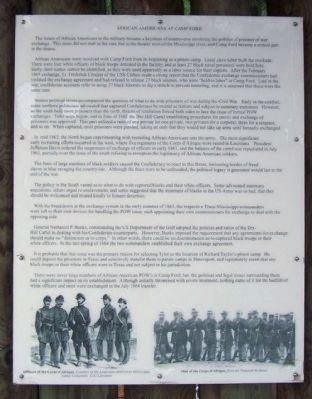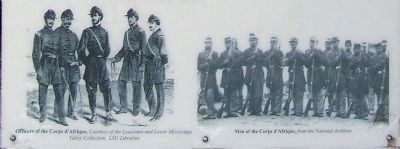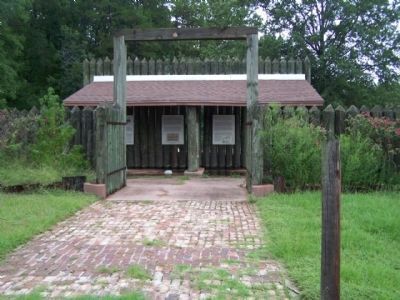Tyler in Smith County, Texas — The American South (West South Central)
African Americans at Camp Ford
African Americans were involved with Camp Ford from its beginning as a prison camp. Local slave labor built the stockade. There were four white officers of black troops detained in the facility, and at least 27 black naval personnel were held here. Sadly their names cannot be identified , as they were used apparently as a labor source for their captors. After the February 1865 exchange, Lt. Frederick Crocker of the USS Cliffton made a strong report that the Confederate exchange commissioners had violated the exchange agreement and had refused to release 27 black seamen, who were "held to labor" at Camp Ford. Late in the war, confederate accounts refer to using 27 black laborers to dig a trench to prevent tunneling, and is assumed that these were the same men.
Intense political issues accompanied the question of what to do with prisoners of war during the Civil War. Early in the conflict, some northern politicians advocated that captured Confederates be treated as traitors and subject to summary execution. However, as the north held more prisoners, threats of retaliation forced both sides to face the issue of formal POW exchanges. Talks were begun, and in June of 1862 the Dix-Hill Cartel establishing procedures for parole and exchange of prisoners were approved. This pact utilized a ratio of one private, two privates for a corporal, three for a sergeant, and so on. When captured, most prisoners were paroled, taking an oath that they would not take up arms until formally exchanged.
In mid 1862, the North began experimenting with recruiting African-Americans into the army. The most significant early recruiting efforts occurred in the west, where five regiments of the Corps d' Afrique were raised in Louisiana. President Jefferson Davis ordered the suspension of exchange of officers in early 1863, and the balance of the cartel was repudiated in July 1863, partially over the issue of the south refusing to recognize the legitimacy of African American soldiers.
The fears of large numbers of black soldiers caused the Confederacy to react to this threat, foreseeing hordes of freed slaves in blue ravaging the countryside. Although the fears were to be unfounded, the political legacy it generated would last to the end of the war.
The policy in the South varied as to what to do with captured blacks and their white
officers. Some advocated summary executions, others urged re-
enslavement, and some suggested that the treatment of blacks in the US Army was so bad, that they should be
welcomed and treated kindly to foment desertion.
With the breakdown in the exchange system in the early summer of 1863, the respective Trans- Mississippi commanders were left to their own devices for handling the POW issue, each appointing their own commissioners for exchange to deal with the opposing side.
General Nathaniel P. Banks, commanding the US Department of the Gulf adopted the policies and ratios of the Dix-Hill Cartel in dealing with his Confederate counterparts. However, Banks imposed the requirement that any agreements for exchange should make no "distinction as to corps." In other words, there could be no discrimination as to captured black troops or their white officers. In the late spring of 1864 the two commanders established their own exchange agreement.
It is probable that this issue was the primary reason for selecting Tyler as the location of Richard Taylor's prison camp. He could deposit his prisoners in Texas and selectively transfer them to camps in Shreveport, and legitimately assert that any black troops or their white officers were in Texas and not subject to jurisdiction.
There were never large numbers of African-American
POW's at Camp Ford, but the political
and legal issues surrounding them had a significant impact on its establishment. Although initially threatened with
severe treatment, nothing came of it for the hadfull [sic] of white officers and most were exchanged in the July 1864
transfer.
Erected by Smith County Historical Society.
Topics. This historical marker is listed in these topic lists: African Americans • War, US Civil. A significant historical month for this entry is February 1865.
Location. 32° 23.779′ N, 95° 16.103′ W. Marker is in Tyler, Texas, in Smith County. Marker is on U.S. 271 near Loop State Highway 323, on the right when traveling north. Touch for map. Marker is in this post office area: Tyler TX 75702, United States of America. Touch for directions.
Other nearby markers. At least 8 other markers are within walking distance of this marker. Camp Ford - Naval Prisoners (here, next to this marker); Camp Ford - Prisoners from Louisiana (here, next to this marker); Camp Ford - Early Days as a Prison Camp (here, next to this marker); Camp Ford Confederate Guards (here, next to this marker); Camp Ford - Establishment of the Camp (here, next to this marker); Cabin of Lt. Col. J.B. Leake (within shouting distance of this marker); Camp Ford (about 300 feet away, measured in a direct line); a different marker also named Camp Ford (about 300 feet away). Touch for a list and map of all markers in Tyler.
Regarding African Americans at Camp Ford. Camp Ford was the largest Confederate Prisoner of War Camp west of the Mississippi River during the American Civil War. Established in August of 1863, the camp was not closed until May 19, 1865. At its peak in July 1864, over 5,300 prisoners were detained there. (Smith County Historical Society)
Also see . . . The Dix–Hill Cartel, Wikipedia entry. an agreement concluded on July 22, 1862 between the Confederate and Union governments to handle the general exchange of prisoners of war. The negotiators were Union Major General John A. Dix and Confederate Major General D. H. Hill. The prisoner exchanges functioned well until December 1862 when Confederate President Jefferson Davis suspended the parole of Union officers following the execution of William Mumford, a New Orleans citizen, by Union General Benjamin F. Butler earlier that year. In reaction, Union Secretary of War Edwin M. Stanton ordered a halt to all exchanges of commissioned officers. General Grant permitted the resumption of exchanges when the Confederate authorities agreed to include all prisoners (Submitted on October 9, 2012, by Mike Stroud of Bluffton, South Carolina.)
Additional commentary.
1. Dix-Hill Cartel
The cited Dix-Hill Cartel article is not completely accurate as Section 7 of the Cartel authorized commanding officers of opposing armies to arrange for the exchange and parole of prisoners captured by them. US General Nathaniel Banks and his CS counterpart General Richard Taylor negotiated and accomplished exchanges from Camp Ford based upon that section. These occurred on July 22, 1864, October 23, 1864, February 25, 1865, and the final one on May 22, 1865, six weeks after Lee had surrendered. The exchange documents were the last official act of the Confederate States.
The only condition imposed by Banks that Taylor could not withhold White Officers of Black Troops from the exchange. Camp Ford was in the District of Texas, and Taylor commanded the District of West Louisiana. He would pull Union prisoners from Ford to Shreveport, and blithely swear that he had no such officers in his jurisdiction. Note To Editor only visible by Contributor and editor
— Submitted December 12, 2015, by Randal B. Gilbert of Tyler, Texas.
Credits. This page was last revised on June 20, 2016. It was originally submitted on October 9, 2012, by Mike Stroud of Bluffton, South Carolina. This page has been viewed 782 times since then and 28 times this year. Photos: 1, 2, 3. submitted on October 9, 2012, by Mike Stroud of Bluffton, South Carolina.


